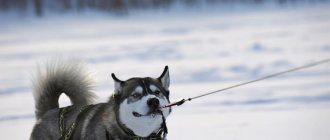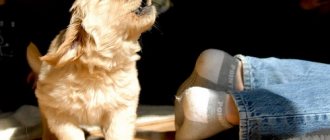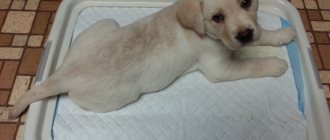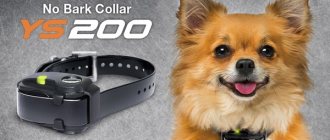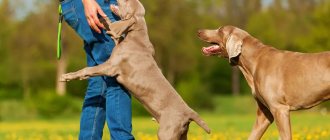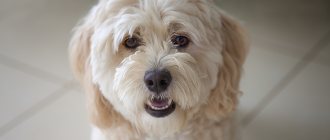Training is the process of education using various methods of influencing a pet.
Often you cannot do without special equipment for this purpose. The collar is the very first and main element of equipment that people use to control and manage their animals.
The choice of collars is extremely large, ranging from simple straps to glamorous works of jewelry. A separate item are collars intended for training, the purpose and capabilities of which have a number of differences . This is a regular collar, various choke and half-choke, strict and electronic. Let's take a closer look at each of them.
Regular collar
This is an attribute of everyday ammunition. But we train our pets not only on the training ground on certain days and hours, but we instill skills in the process of constant daily communication .
Such a collar must meet the main requirements - to be reliable, durable and comfortable:
- of sufficient width and appropriate size with the possibility of adjustment;
- Quite soft, double or padded; usually made of leather, canvas, nylon (products made of plastic or metal are not suitable);
- reliable fastener - belt type or metal snap fastener (plastic fasteners are unreliable); the ring for attaching the leash carabiner must be welded and also well secured;
- The joints are stitched or riveted.
The collar should not be worn too tightly or dangle around the neck. Metal chains, narrow or with an abundance of decorative elements are not suitable for classes.
In most cases, such a collar is enough for successful training.
Corrective harness for dogs
It is the most humane way to control a dog that is pulling hard on a leash. Thanks to the leash fastening ring located on the chest, when pulled, the dog turns to face the owner, in the direction opposite to where the dog is pulling. Corrective harnesses are also used when working with dogs that are afraid to go outside or with fearful dogs. A dog can wriggle out of a regular harness during a panic attack. The corrective harness compresses when the leash is pulled, depriving the dog of the opportunity to break free and run away.
Nooses, half-nooses, ringovki
Noose
represents a sliding loop that tightens when pulled or pulled. Typically made of metal links, nylon or leather.
The principle of influence is based on causing the animal a state of discomfort and eliminating it when the leash is loose. The noose is not intended for everyday wear on walks for several reasons :
- when free-range, it falls off when the head is tilted, so it is easy to lose;
- the dog may get caught on a branch or other protruding part of the surrounding landscape and receive serious injuries;
- when playing with other dogs, if your paw gets caught in a loop, there is a risk of injury to another animal;
- An excitable or untrained pet, constantly pulling on the leash or making sharp jerks on the noose, quickly gets used to causing discomfort and stops responding to it.
The ease of use is that the noose can be easily and quickly removed over the head when necessary.
A half-choke collar (martingale) differs from a choke collar by the presence of a stopper, which allows the loop to be tightened only to a certain limit.
Martingale refers more to ammunition for everyday use, rather than for correctional education.
It, like the noose, can be quickly removed and put on over the head. Suitable for long-haired breeds to avoid matting. Suitable for excitable, fearful or aggressive dogs, as it prevents them from turning away and running away.
The noose and martingale in a free state should not hang from the neck by more than 4-8 cm . When playing with dogs, these types of equipment must be removed to avoid injury or death.
A show ring (in common parlance, a “leader”) is a collar, or a single combination with a leash, intended for displaying an animal at an exhibition. It is, as a rule, a rather narrow, smooth round cord with a retaining ring and a hand loop. It must be durable and not conspicuous, so as not to distract attention from the competitor and allow the exterior to be appreciated. According to the design principle, although the ringovka is similar to a noose, it should not be a means of correction.
How to choose a collar for a dog
Every dog should have a collar, but choosing one is not as easy as it might seem at first glance.
Special dog equipment exists not only for each group of breeds, but also for certain cases and different types of training. Soft classic collar (walking, with a handle for protective guard service (PSS), guard).
These collars are made from leather, synthetic material, or a combination of both. Typically, such collars have soft lining (felt, fleece, thin leather with soft filling) to provide the dog with maximum comfort.
Walking collars are the most common type. As a rule, they have one half-ring for attaching a leash. It can be located near the buckle, which will not prevent the animal from moving its head in this case. Or on the opposite side of the collar - then the owner will not need to look for a ring to fasten the dog (the buckle, as the heaviest part, tends downwards on the dog’s neck).
The protective training collar is equipped with a comfortable handle so you can hold your dog. The leash ring is placed either on the handle itself or immediately below it. Usually there is another half-ring near the buckle, and when working from a leash it is better to fasten the dog to it.
The guard collar is the most reliable, time-tested type. It is designed to keep the dog on a leash at all times, so it must have increased strength. Its main feature is that the collar strap is first passed through a half-ring, and then fastened with a buckle. Thus, the dog's tugging forces are applied not to the buckle and fastening holes, but to the dense material passed through the ring. The buckle is also located on top and does not interfere with the dog.
Choke collar (metal chain, leather, synthetic).
Such collars are most often used as training or exhibition collars. However, their low weight makes them convenient in everyday life. The suffocating effect of collars is perceived by dogs as closest to the natural conditions of rearing in a pack: a mother teaches her cub by lightly strangling its neck.
However, any such influence on a dog, especially a puppy, must be precise and short-term, otherwise all educational value will be lost. An experienced instructor, before allowing a beginner to use such a collar, must tell and show in detail how exactly the effect on the dog should occur.
Metal or snatch chains must be made of a durable alloy, all links must be soldered or welded, and the coating must be applied in such a way as not to injure the dog. Nowadays, many dogs suffer from allergies to nickel-containing alloys. Therefore, a special composition based on copper was developed - kurogan, which is slightly darker and redder in color than brass, but does not cause allergies in dogs.
It must be remembered that some low-quality chains can stain the coat of light-colored dogs. Therefore, before going to the exhibition, it is better to try it out. Another note: short-haired dogs or dogs with long fluffy hair are displayed on thin, almost jewelry-like chains. So as not to visually divide the dog’s neck and so that the fur does not get crushed. But the larger the link, the less the chain cuts the dog’s hair. Therefore, shepherd dog owners use chains with long (up to 5 cm) links.
Parfors collar (strict).
This type should be considered special and used under the supervision of experienced instructors. The main feature is the presence of spikes, which, when pulled, cause discomfort to the dog. Such a collar is selected strictly according to the circumference of the neck; it should be located immediately behind the ears, not dangle or fall off. One of the most famous manufacturers of high-quality metal collars is the German company Sprenger.
Their product range includes several types of parfors - wire and plate, with long spikes for long-haired dogs or short spikes for smooth-haired dogs, made of various metals and with various coatings. The latest development of this company is strict collars, the spikes of which are located on both sides of the central plate in the area of the dog’s Adam’s apple. This arrangement, experts say, creates more natural pressure on the dog’s neck, simulating a mother’s bite or pinch.
The dog should not always be in a strict collar - it can only be used during training and only in cases where all other methods of achieving obedience have been tried. The total infatuation of inexperienced dog owners, who dress puppies from 5 months in “strogs”, has a detrimental effect on the overall obedience and ability to control the animals.
Show collar
It should be such that it does not distract attention from the dog (as a rule, it is matched to the color of the coat). It is important that it does not visually divide the animal’s neck, while being comfortable, reliable and practical. In most cases, these are either synthetic rings made from a thin cord or a noose chain.
However, there are several breeds, including German Shepherds and Dobermans, whose exhibition requires the dog to run for a long time in the ring. In this case, the animal must run in front of the handler with its head held high. In such cases, specialists use metal or leather rings with Adam's apples. The Adam's apple can be metal or leather, with spikes (if the dog pulls hard) or without, with a special shelf to raise the dog's head even higher.
The collar can be selected for any breed. However, it is necessary to take into account the peculiarities of the anatomical structure of the respiratory tract of some dogs. For example, pugs and other short-faced breeds are very sensitive to pressure in the neck area and can choke, so they are recommended to be driven in harnesses. For graceful dogs (for example, greyhounds), collars that are wide in the front of the neck are used. But in any case, the collar should be as reliable as possible so that it does not break during wear.
Rules for selecting a dog collar
A soft collar should be chosen in such a way that when fastened to the middle hole (that is, usually two more holes on the smaller and larger sides), it does not dangle around the dog’s neck. Usually the owner’s thumb should fit under it: if it’s less, it will put pressure, if it’s more, it may fall off or rotate on the neck.
If you are choosing a collar for a puppy, you need to keep in mind that the dog will grow. This means that the size of the collar should be such that, firstly, it is possible to increase its size, and secondly, so that the free part of the strap is not very long and does not interfere with the comfort of the collar. That is, now it should be fastened to the outermost inner hole, and as it grows, the owner will be able to fasten the collar to the size of the pet’s neck.
In any case, it is not a good idea to wear collars all the time, as they can dry out the dog’s fur and cause discomfort and inconvenience to the dog. If there is a need to restrain a dog at home, then it is better to use a thin leather noose for this purpose.
Calling a veterinarian to your home.
Choosing a dog collar size
The choice of size depends on the type of collar. For example, soft and parfors should securely clasp the dog’s neck, but not cause discomfort to the animal. In this case, the owner just needs to measure the circumference of the pet’s neck and choose the appropriate collar. But in such a way that if the size changes, it can be adjusted.
Nooses, as a rule, are put on over the dog's head, so the main size is the circumference of the head at the widest point - around the ears. Otherwise, you simply won't be able to put it on. However, a collar that is too large will make the jerks during training longer and the dog more difficult to control. The optimal size will be 2-3 cm larger than the girth of the dog's neck.
How to keep your collar clean
Caring for your collar depends on the material from which it is made. For example, it is better to wet the skin less and not dry it near an open fire. You can wipe it with special impregnations, which will provide not only a good appearance, but also moisture resistance to the material. In this case, the collar will not lose its appearance for a long time.
Synthetic collars can be washed as needed. Moreover, the dog can swim in salt water in them. But it is necessary to monitor the metal elements of the collar - rivets and buckles from irresponsible manufacturers can rust. Therefore, it is better to purchase products with fewer decorations. Not only can they ruin the appearance of the product over time, but the holes also weaken the material of the collar, making it less reliable.
Collars need to be disinfected if a sick animal has been in contact with them or if there is a need to use a collar that previously belonged to another dog. This should be done as rarely as possible, since it is very difficult to properly disinfect a non-metallic collar. It is better to provide each animal with an individual set of ammunition.
Which material is stronger
Collars are made from durable leather, synthetic sling or cord, metal, or combinations thereof. Leather is the most pleasant material for both humans and animals. High-quality thick leather will always be fashionable and beautiful, and will last for many years. However, like any leather product, such a collar will require careful handling and special care.
Synthetics can be considered the most durable of the materials for making soft collars. Resistance to external influences and various weather conditions make them indispensable in everyday life. Moreover, the owner can choose the color, width and design to his liking.
The most durable and reliable can be considered a soft collar made from a combination of leather and a synthetic sling. With high-quality manufacturing and reliable fittings, this combination will be a win-win for a guard collar or for training large dogs for protection. It is clear that high-quality metal collars can last more than one “dog” generation. However, you should not use such a collar in the cold season, as there is a danger of frostbite.
You can easily sew a collar yourself for your pet. But you need to remember that the safety of not only those around you, but also your pet often depends on its reliability. Therefore, you need to take into account the size and strength of the dog and choose materials and accessories so that their tensile strength exceeds the pet’s weight by at least 5 times.
Replacing the collar
Typically, an experienced dog owner has several types of collars. “Going out”, daily, training, exhibition, home. However, with high-quality and timely training, one reliable and high-quality collar may be enough for the owner in everyday life.
Changing the collar goes completely unnoticed for an already prepared animal. Moreover, for most dogs, a collar is associated with a walk and a good time. But the pet is able to guess by its weight what kind of collar it is wearing. This problem is relevant when using parforces and shock collars. A dog can obey perfectly in them, but in a regular collar it cannot obey at all. This is the main problem with using special means in dog training.
Fashion trends in dog collars
When choosing a “glamorous” collar, you need to make sure that the rhinestones and rivets do not form sharp protruding parts, especially on the inside of the collar, so as not to injure the dog. Remember that the protruding parts on its outer side can also injure the owner or another dog, so such collars can only be worn “out”, and you should not let the animal play with its relatives in it.
Leather collars with spikes, which supposedly should protect your animal from being bitten in the neck during a fight, also turn out to be of little use. Using such an accessory, the owner himself is more likely to get hurt while leading the dog on a leash, but a foreign animal can bite in another, even more sensitive place.
It must be remembered that any hole in the material of the collar weakens it and significantly reduces the service life of the product. Therefore, before you put on any collar (even one that you use every day), you need to inspect it for damage. And if there are any, then it is better to refuse to use such ammunition. The life of a pet is more important than external beauty.
Collars with navigator for dogs
Technology does not stand still and collars with navigators have become a big breakthrough, especially in the field of searching for lost pets. Although they were originally developed for hunters whose dogs must go far into the forest in search of game, such collars are now increasingly being seen on the necks of ordinary domestic animals.
Usually this is a whole system consisting of a collar, a device for transmitting a GPS signal on it, as well as a remote control receiver, which is located by the owner. The cost of these systems depends on how the remote control helps the owner find the dog: it can be a sound signal showing in which direction to move, or an entire map showing the pet’s location. On average, it varies from $200 to $600.
Therefore, not every owner can afford such a device.
The address capsule, of course, will also help you find the dog, but for this you need a person who can look into it. Finding a dog from a satellite is a fantasy that has become reality. All that remains is to wait for the prices for such devices to drop.
Strict collar (parfors)
This accessory (in everyday life “planer”) consists of metal links or plates with spikes pointing inward. The principle of operation is the same as that of a noose, but the unpleasant effect is much stronger. For training and correction, it is sometimes used for temperamental and strong individuals .
It is very important to wear the collar correctly. Parfors is located strictly behind the ears - in the narrowest part of the neck, fitting tightly to it. The ring for attaching the carabiner of the leash is located strictly at the top. A parfors dangling at the bottom of the neck is ineffective with constant tension, and can cause injury if jerked.
There are a number of restrictions and precautions for using this type of equipment:
- not intended for constant wear, as the dog gets used to its effects;
- applicable only under the supervision of an experienced dog handler (it is necessary to obtain at least advice on its correct use);
- not used to correct a cowardly, aggressive or joyful state;
- when playing with animals, it must be removed to avoid injury to another dog;
- cannot be placed on a leash with a parfors on;
- if used incorrectly or overexposed, behavior can worsen (often non-cooperation, fear or aggression).
Exhibition metal chain collars
Quite often, when choosing a show collar, dog owners make the mistake of choosing bright, noticeable collars. Of course, such a collar looks beautiful and stylish. But at the exhibition, the equipment should not stand out and distract attention from the dog’s appearance.
Most often, exhibitors prefer to wear ring collars or elegant chain collars on their pets.
For long-haired dogs, such a collar favorably demonstrates the beauty of their coat, and on smooth-haired animals it looks very impressive.
Electronic collar
And finally, a product of modern technology, abbreviated as REO (electronic collar), or EShO (electric shock collar).
By the way, the common name of EShO by analogy with an electric shock baton will be incorrect, since if it is used correctly, the dog should not receive any shock .
It is a fastening belt with a receiver box and a remote control for sending a signal.
This piece of training equipment has both a considerable number of ardent opponents and quite loyal supporters. This type of equipment is applicable only in the hands of an experienced, skilled trainer and has even more restrictions for use. This device can only help solve a number of narrowly targeted tasks.
It is very popular solely due to its high cost, which leads to advertising by sellers and PR in solving almost all problems. This, of course, is not true, although in some cases correction may be effective. The main advantage compared to other types of training equipment is the possibility of remote use over a considerable distance. Some other functions, in addition to the effect of an electrical impulse, are even very convenient and indispensable.
EOs are conventionally divided into types according to the functions built into them.
The purpose of anti-bark is clear from its name. The principle of operation is based on the delivery of an electrical impulse in response to vibration of the vocal cords. When the barking stops, the effect of the current ends.
In some models, a warning sound or vibration sounds before the current is applied, which forces the pet to stop barking before the unpleasant effect begins.
It is highly advisable to use anti-barking only as a last resort remedy. First, it is necessary to identify the causes of this behavior and eliminate them by other methods.
Otherwise, due to prolonged stress and frustration, there is a high probability of mental disorders and deterioration in the behavior of the ward. Anti-bark products that respond to sound vibration should not be used. Other animals barking around or other unexpected loud noises may trigger the impulse. This use of EO is unjustified and borders on cruelty.
Another application of EO is carried out by varying the supply of an electrical impulse using a remote control in the hands of the trainer.
Correct use involves the ability to timely deliver a short impulse at the moment the animal intends to perform an undesirable action (negative reinforcement) or to stop long-term exposure to an impulse until the unwanted behavior is eliminated (positive punishment).
The latter option is rarely used by professional dog handlers, but is often, and ineptly, used by amateur dog breeders. Both the strength of the current applied, depending on the specific situation and the susceptibility of the individual animal, and the frequency of the signal are of great importance.
Some articles and manuals short-sightedly explain that using EO is easy. It is enough to give a command and press a button on the remote control so that the dog stops this or that action.
Insufficient understanding of the principles of behavior formation and knowledge in the field of animal behavior, emotional imbalance of the owner, and mental instability of a sensitive animal significantly limit the possibility of using an electronic collar.
The next function is the vibration mode signal. Does not cause unpleasant or painful sensations. The vibration signal is used as a conditioned reinforcer (just like a verbal command). When properly eliminated, unwanted actions replace the effects of an electrical impulse. Use in vibration mode can be indispensable when training and controlling the behavior of dogs with hearing loss.
Another feature that is additional to the electric collar is a GPS navigator. The ability to track the location of a dog will help you quickly find a lost pet and track the movement of a dog that is carried away by the search and rutting while hunting.
In conclusion, it should be said that correcting a dog’s unwanted behavior through suppression and punishment is not the main principle of training and is far from the most effective part of it. Any living creature is more willing to cooperate and communicate with a person when being raised by rewarding us for actions we need , rather than punishing us for unnecessary ones.
Whatever methods of training and raising dogs you adhere to, it is important to understand: any equipment is just an auxiliary means for successfully achieving goals and does not solve anything without sufficient knowledge and skillful use. The main characters in training are you and your dog.
Leather and canvas collars
The most common collars are for everyday use. They are suitable for almost all dogs, with the exception of those breeds whose neck circumference is equal to the head circumference. Such dogs can simply “slip out” of it. Everyday collars come in leather, canvas, or nylon.
What you need to pay attention to when choosing a leather or canvas collar:
- Its width should correspond to the size of the dog.
- Select the collar in such a way that two fingers fit freely between the dog’s neck and the collar, but the pet cannot “slip out” of it.
- It is desirable that the rings and buckles are welded. In the event of a jerk, they will not straighten up. It is better if the ring is fixed at some distance from the buckle. This design is more durable, since the load on the ring and buckle will be distributed evenly.
- Choose a collar with as many holes as possible. Just like in humans, the girth of an animal’s neck can change depending on the season, molting and other conditions. And the skin itself tends to deform depending on weather conditions (get wet and stretch or shrink and shrink).
- It is best to choose a two- or three-layer collar, but not hard, so as not to rub your neck.
For active and strong dogs (such as Jack Russell Terriers), there are leather collars with a special extension under the throat. This reduces the force on the neck if the dog actively pulls forward. In common parlance, this type of collar is called a “herring” because of its unusual shape.
For very small puppies, you can take a soft collar with a semi-automatic clasp (Fastex). As your baby grows, you can independently adjust the neck circumference using the buckle located on the collar. And when the puppy has already matured and become stronger, then you can safely select a collar suitable for your breed.
In recent years, new innovative materials for making collars have appeared. For example, high-tech elastic rubber. These collars are hypoallergenic, easy to clean and resistant to temperature changes. They do not get wet and, thanks to the micro-adjustment system, are easily adjusted to the size of the tail's neck.
Puppy takes off his collar
As we have already said, it is best to accustom a puppy to a collar from a very early age - from 2-3 months. It is during this period that babies come to their owners from breeders.
Here it is worth recalling a couple of simple rules that should be followed so that the dog does not try to pull the inconvenient noose over his head, but gradually gets used to its presence.
- For the first time, it is better to purchase a collar made of sling or tarpaulin, equipped with a plastic carabiner. It allows you to conveniently adjust the size without being limited by a number of pre-drilled holes. In addition, he will not be so sorry if the puppy decides to try a new thing on the tooth.
- The collar must be worn correctly - a finger must be placed between it and the animal's neck. This is enough to prevent the dog from choking and to make the collar difficult to remove.
- During the first fittings, you need to distract your pet from the discomfort. This can be done with a treat or, better yet, a game. This way the habit will develop much faster. And, of course, under no circumstances should you attach a leash right away, so as not to cause even more discomfort.
With this approach, wearing a collar in adulthood will not cause inconvenience or cause problems.
Flea collars
Most often, the problem in which a dog refuses to wear a collar is related to parasite medications. Here we should dispel several myths about these funds. Firstly, they do not help treat an existing flea infestation, this is only prevention applicable to a healthy animal. Secondly, their effect usually ends somewhat earlier than the specified dates. Thirdly, they do not help in conditions of constant presence among other infected animals or in a house that has not been treated for fleas.
Such collars usually do not smell anything to humans. The dog smells a lot of smells from them. They may irritate or frighten her. When mixed with water or dirt, they can also become saturated with them and smell damp (this depends on the material of production). And, of course, when the dog itself takes off the flea collar and refuses to walk in it, there is a high probability of an allergy. This can be determined by carefully examining her neck. There may be areas of lost fur, irritated red skin or small spots on the skin. The animal will constantly try to scratch them.
An adult dog takes off his collar
With puppies, everything is quite simple, and there is only one reason, and it is quite easy to fix - you just need to pay enough attention at first. But adult individuals are already distinguished by their formed character and their habits, and it is much more difficult to overcome them. But let's get back to the reasons.
The first reason why a dog may stubbornly remove the collar is sudden inconvenience and unpleasant sensations. To verify this is quite simple - unfasten the collar and feel the place under it along the entire circumference of the neck. It is likely that there may be a tick under the collar or there may be wounds on the skin. They can be caused by allergies (especially if your pet is wearing an anti-parasite collar) or irritation from the heat. In both cases, you can also find falling fur, scratching, or even weeping wounds.
The second reason is lack of education and training. This is especially common for owners who pick up animals from the street. Such dogs are much more cunning and resourceful than domestic dogs, so they quickly realize that the annoying noose can be pulled over their heads. In addition, in childhood no one taught them to wear a collar, and in adulthood (after 1 year), this is much more difficult to do. In addition, some breeds are very active, so attempts to escape may be due to the fact that the dog needs to expend energy.
What should owners of wayward pets do in this situation? The question is quite complex, but a couple of tips can still be given.
- For dogs living outdoors, it is better to choose wide synthetic collars with a full buckle closure. Unlike leather ones, they do not stretch over time, and it is much more difficult to tear such models.
- For walks, if a naughty dog is used to breaking off the leash, it is better to choose a different collar model. Experienced dog breeders suggest using a strict collar or a snare leash for maximum control. With their help, with due attention, you can let the dog know in advance that it is not worth tightening the collar.
And of course, we can advise you to spend more time with your pet. It is quite possible that he simply does not have enough walks and your attention.
Sudden refusal of a permanent collar
It also happens that a usually calm and patient dog removes the collar over its head and whines when trying to put it back on. If this is not a medicinal product, which can be suspected of expiration, but her usual strap, then there must be some reason for this in her well-being. It is necessary to examine the neck and check for ticks, wounds, traces of massive flea bites, lumps and inflammations. By pressing on the damaged areas, the collar will irritate the dog.
It may also happen that your pet suddenly becomes afraid of his walking collar. Most likely, something unpleasant happened to him recently and now there is an association that he cannot overcome. It could have been some kind of frightening or painful experience. In this case, you can switch to a harness, which in any case is considered a more adequate and gentle option for animals. You can also purchase a new collar over time - it is useful because the owner’s address and telephone number can be attached to it, and gradually accustom the dog to it. The purchase should be left nearby so that it can be examined and smelled. Showing tenderness to your pet, you can pick up the collar, stroke it a little, and carry it with you on walks, thus forming positive associations.
In pursuit of a brighter accessory for their pet, owners do not always pay enough attention to the material from which it is made. But not all manufacturers are so conscientious as to use only the best technologies for their smaller brothers. It is better to pay a little more and buy only one collar, rather than two, but of high quality. You should avoid plastic, metal (too cold in winter) and silk (such straps tend to tighten around the neck, causing real suffocation in small but active animals). The same rule applies to therapeutic collars.
What to do if a dog rubs its neck with a collar?
Perform a series of sequential actions:
- remove the strap as soon as you notice that the dog has rubbed its neck with the collar;
- Gently wipe the affected area with a cloth moistened with the solution
- chlorhexidine or furatsilin - effective antiseptics that do not cause
- burning;
- if the rubbed skin is not damaged, after drying, sprinkle the area with talcum powder or apply soothing creams based on coconut oil, medicinal chamomile, aloe or other products from a pet store (vaseline cannot be used, as dogs tend to lick ointments);
- give the skin time to heal and search for a more suitable collar or a more comfortable alternative;
- Consult your veterinarian for additional treatment if you do not notice improvement in the irritated area after three to seven days (wounds can become infected by bacteria or fungi).
